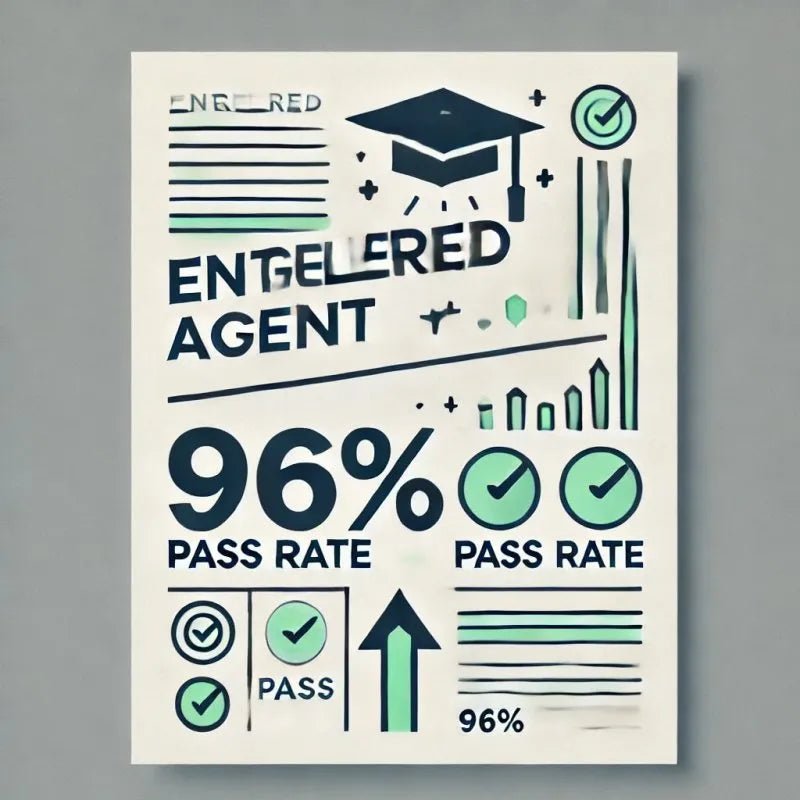Enrolled Agent Study Plan Strategies
Enrolled Agent Study Plan Strategies: Your Key to Success
Enrolled Agent study plan strategies are essential to efficiently prepare for the EA exam and maximize your chances of passing on your first attempt. Whether balancing a full-time job or having more flexibility, an effective study plan tailored to your pace is critical.
This guide provides comprehensive strategies for breaking down your study time, focusing on critical exam areas, and incorporating active learning techniques to ensure you master the material.
Enrolled Agent Study Plan Strategies
Know the Structure of the Exam
Before diving into your study plan, it's crucial to understand the exam's structure:
- Part 1: Individual Taxation: This part covers the fundamentals of individual tax return preparation, including income, deductions, credits, and filing statuses.
- Part 2: Business Taxation: This course focuses on the taxation of various business entities, including sole proprietorships, partnerships, and corporations, as well as business financial information.
- Part 3: Representation, Practices & Procedures: Test how tax professionals represent clients, ethical conduct, and procedural standards before the IRS.
Ready to pass? Join Surgent’s Enrolled Agent course with AI tech and a 96% success rate. Get started today!
Each part consists of 75 multiple-choice questions; mastering this format is critical. Practice exams are essential for familiarizing yourself with common question types. Eduyush's EA syllabus Guide offers a detailed breakdown of each part.
Time Management: The Foundation of Your Study Plan
Effective time management is critical to covering the vast material in each part of the EA exam.
2.1 Assess Your Availability
- Full-time workers: Aim for 10-15 hours per week of study, balancing evenings and weekends.
- Part-time workers or students: You can commit 20-25 hours per week, which allows for more frequent practice exams and deeper dives into complex topics.
2.2 Breakdown by Parts
Allocate study hours based on the complexity of each section:
- Part 1: Individual Taxation – 60 to 80 hours
- Part 2: Business Taxation – 80 to 100 hours
- Part 3: Representation, Practices & Procedures – 50 to 60 hours
This adds up to approximately 190-240 hours of study time, which can be spread over 4-6 months. Read Eduyush's detailed advice on time management for the EA Exams for deeper insights.
Develop a Targeted Monthly Study Plan
Your study plan should have structured milestones. Below is a 4-to 6-month study plan to ensure consistent progress.
Month 1: Individual Taxation Foundation
- Goal: Master the basics of individual tax returns (Form 1040, schedules, filing statuses).
-
Strategy: Spend 60-80% of your time reading materials like IRS Pub 17 and use the remaining 20-30% for practice questions.
- Focus: Taxpayer data, income types, deductions, credits.
For Month 2: In-depth Individual Taxation Review
- Goal: Review complex areas like the Earned Income Tax Credit (EITC), child and dependent care credits, and various income sources (capital gains, dividends, etc.).
- Strategy: At the end of this month, take a full-length practice test for Part 1, highlighting any areas that need more attention.
Month 3: Business Taxation
- Goal: Study business entities (sole proprietorships, LLCs, partnerships, corporations) and related tax forms (Schedule C, Form 1120, Form 1065).
- Strategy: Use 50% of your study time for reading and 30% for problem-solving, such as reviewing past years’ business tax forms. Check out this guide on business taxation.
For Month 4: Advanced Business Taxation
- Goal: Master depreciation, inventory accounting, and cost of goods sold (COGS), as well as S-corporation and partnership taxation.
- Strategy: Complete a full-length practice exam for Part 2 by the end of the month.
Month 5: Representation, Practices & Procedures
- Goal: Study Circular 230, representation before the IRS, ethical guidelines, and IRS collections.
- Strategy: Dedicate significant time to reading IRS Pub 947 and completing practice questions.
Month 6: Final Review and Practice Exams
- Goal: Review all three parts thoroughly.
- Strategy: Focus on weak areas identified through practice exams. Take two full-length mock exams for each part and review incorrect answers.
Study Techniques for Success
Reading alone isn’t enough to pass the EA exam. Here are some active study techniques:
Active Recall & Spaced Repetition
- Use flashcards or apps like Anki to test yourself on key concepts regularly. This method is effective for retaining tax rules for a long time.
- Schedule multiple revision sessions for challenging topics, spacing out the intervals to enhance retention.
Practice Questions & Mock Exams
- After completing each major topic (e.g., income, business entities), complete 20-30 practice questions. This will reinforce your knowledge and reveal gaps.
- By completing 75% of your materials, take full-length, timed practice exams to simulate the actual test environment. Eduyush's practice questions are excellent for honing exam skills.
Case Study Approach
- Create tax scenarios for yourself, such as comparing the tax treatment of a sole proprietor versus an S-corporation. This will help you apply theory to real-world practice, especially for business taxation.
Balance and Breaks
I am studying nonstop, which leads to burnout. Implement the Pomodoro Technique: Break study sessions into 25-minute focus intervals, followed by a 5-minute break. After four intervals, take a more extended break.
- Rest: Get 7-8 hours of sleep daily to improve retention. Avoid cramming the night before the exam.
Know Your Weaknesses
Throughout your preparation, track where you struggle. Allocate additional time to review these areas:
- If business taxation proves difficult, spend more time on corporate and partnership taxation by reviewing IRS guidelines and related forms.
Test Day Strategies
When exam day arrives, follow these strategies:
- Pace Yourself: With 75 questions per section, you have about 1.5 minutes per question. Don’t dwell on difficult questions—mark them and return later.
- Elimination: Narrow down choices using the process of elimination, especially when unsure of the correct answer.
- Stay Calm: Trust your preparation. Your months of studying have equipped you with the tools you need to succeed.
Final Thoughts on Enrolled Agent Study Plan Strategies
Successfully passing the Enrolled Agent exam requires discipline and a well-structured plan. By following this guide, you’ll be on track to mastering the material, earning your EA credential, and opening up new career opportunities in tax law. Stay consistent with your study schedule, utilize the right resources, and ensure you take plenty of practice exams. Remember, it’s a marathon, not a sprint—pacing yourself will lead to long-term success.
For more comprehensive resources and practice exams, visit Eduyush’s EA Exam Resources to boost your preparation further.
Become an Enrolled Agent
96% Pass Rate on Surgent EA course
1️⃣Now Available in India at 45% Off
2️⃣Unlimited Course Access Until You Pass
3️⃣Expert Support & Comprehensive Study Materials
4️⃣AI-Driven Study Plan for Efficient Learning
Questions? Answers.
How do I become an Enrolled Agent?
To become an Enrolled Agent, you must:
- Pass the Special Enrollment Examination (SEE), which is a three-part exam covering:
- Alternatively, if you have experience working for the IRS (at least five years in a relevant tax position), you may qualify without the exam.
- Apply for enrollment by submitting Form 23, “Application for Enrollment to Practice Before the IRS,” and undergo a background check to ensure you comply with tax laws.
What is the Special Enrollment Examination (SEE)?
The SEE is a three-part exam that tests your knowledge of tax laws and your ability to represent taxpayers before the IRS. Each part of the exam focuses on different aspects of U.S. tax law:
- Part 1: Individual Taxation
- Part 2: Business Taxation
- Part 3: Representation, Practices, and Procedures
You must pass all three parts within a two-year period. The exam is administered by Prometric and is available year-round.
How do I renew my Enrolled Agent status?
To renew your EA status, you need to:
- Complete Form 8554, “Application for Renewal of Enrollment to Practice Before the IRS,” and submit it before the expiration of your current enrollment cycle.
- Confirm you have met your CPE requirements for the three-year period.
- Pay the renewal fee (currently $140 as of 2024).
Your renewal period is based on the last digit of your Social Security Number:
- 0, 1, 2, 3: Renew by January 31 of years divisible by 3 (e.g., 2026, 2029).
- 4, 5, 6: Renew by January 31 of the year following those divisible by 3.
- 7, 8, 9: Renew by January 31 two years after the year divisible by 3.
Can I lose my Enrolled Agent status?
Yes, an EA can lose their status for various reasons, including:
- Failure to meet CPE requirements.
- Failure to renew your enrollment by submitting Form 8554.
- Unethical behavior or violations of IRS regulations (e.g., tax fraud, negligence).
If you lose your status, you will need to reapply and, in some cases, retake the SEE to regain your credentials.
How can I track my CPE hours?
It’s important to track your CPE hours to ensure you meet the requirements. Many IRS-approved providersautomatically track your hours and issue certificates for each course. You should:
- Keep a record of completion certificates from each CPE course.
- Use a spreadsheet or online tracking tool to log your hours and ensure you meet the yearly 16-hour minimum.
Some CPE providers offer dashboards that allow you to track your completed courses and hours in real time.
What is the difference between an EA and a CPA?
While both EAs and CPAs can represent clients before the IRS, there are key differences:
- EAs specialize in tax and have unlimited practice rights to represent taxpayers before the IRS in tax matters.
- CPAs can offer a broader range of services, including auditing, accounting, and financial planning. However, their ability to represent clients before the IRS in tax matters is typically limited to those for whom they have prepared tax returns or provided other services.
EAs are generally seen as tax experts, while CPAs have a more generalized accounting background.
What is Form 23, and when do I need to file it?
Form 23 is the “Application for Enrollment to Practice Before the IRS.” You file this form:
- After you pass all three parts of the SEE, or
- If you qualify based on prior IRS work experience (at least five years in a relevant position).
Filing Form 23 is the final step in becoming an Enrolled Agent. You must also pass a background check and pay the initial enrollment fee.
How long does the EA enrollment process take?
- After passing the SEE, you must submit Form 23.
- The IRS will conduct a background check to ensure you have complied with U.S. tax laws.
- The approval process typically takes 60-90 days, depending on the completeness of your application and the IRS's review workload.
Where can i read detailed guidelines for specific areas?
We have addressed most of the EA questions in our blogs. Refer to these blogs
Resources to pass the EA Exams
Here are all the relevant resources you can use to pass the exams
- Enrolled Agent CPE Requirements: Complete Guide for EAs
- Enrolled agent diagnostic report: How to use it
- Enrolled Agent Exam Centers in India: Complete Guide
- Enrolled Agent Exam Cost: A Complete Breakdown
- Enrolled agent exam retakes: Study strategies
- Enrolled Agent Exam Sample Questions: Part 1 Individuals
- Enrolled Agent Exam Scores: Everything You Need to Know
- Enrolled agent exam time management
- Enrolled Agent Exam: Your Complete Guide to Success
- Enrolled Agent Renewal: Complete Guide to Renew Your EA Status
- Enrolled Agent Salary in India: A Complete Overview
- Enrolled Agent Study Plan Strategies
- Enrolled Agent Syllabus: Complete Breakdown for 2024
- Enrolled agent test preparation
- Enrolled Agent: Your Guide to Becoming an EA
- How to Fill Form 8554 for Enrolled Agent Renewal
- How to get a PTIN: Step by Step guide
- PTIN Renewal Deadlines: What Happens If You Miss the Deadline?
- Enrolled agent course














Leave a comment